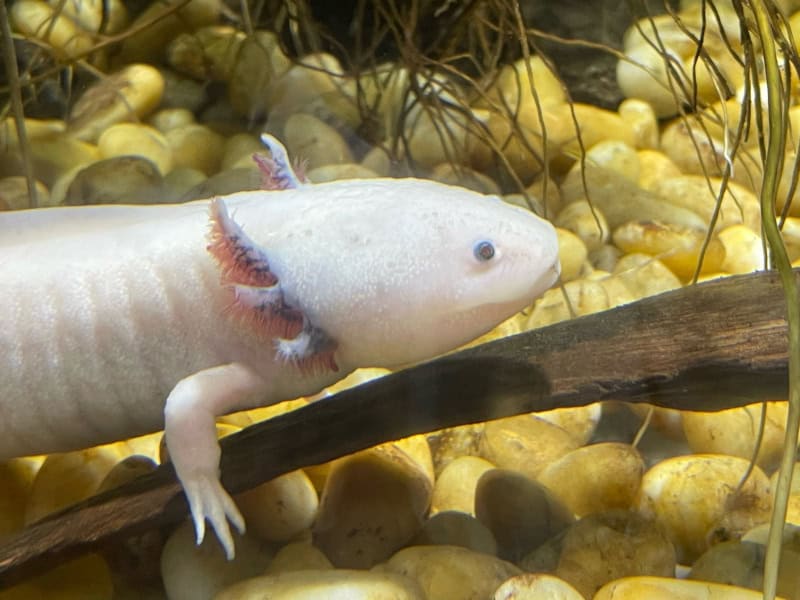Axolotl Facts
- This extraordinary creation of Nature and evolution is a species of amphibian best known by the decptively simple term of Axolotl. This actually derives from an ancient Aztec word meaning water dog. For the moment, this natural marvel has no other generally used name.
- Within scientific circles, however, the creature’s perhaps much better known by its technical title. Like many such terms, though, that’s somewhat hard for the layperson to pronounce. That’s because the biological wonder holds the formal moniker of Ambystoma mexicanum.
- The English zoologist, George Shaw, and the English illustrator, Frederick Nodder, hold joint credit for bestowing this name. The pair accomplished the first acknowledgement of it as a separate and distinct species. This scientifically noteworthy action occurred in the year 1798.
- No matter which of these terms one chooses to use, however, it’s a fascinating creation of evolution. It’s often confused with a related species, the tiger salamander. Today, the animal represents a frequent and intense subject of study due to its remarkable regenerative abilities.
- Sadly, the remarkable Axolotl currently appears to be rapidly declining in numbers. This unfortunate trend further seems to hold true throughout the entirety of its known, and limited, range. The IUCN therefore presently lists the animal as Critically Endangered on its Red List.
- Its own habitat range limits its potential for maintaining a stable population base. Yet it also faces other threats as a species in addition to this factor. Many of these are due directly to the actions of man. They include habitat loss, and of course, now the effects of climate change.
Related Articles
Axolotl Physical Description
The remarkable Axolotl possesses a truly extraordinary physical appearance, to say the least. It’s the characteristic that typically first catches the eye of any observor. Even the fully mature adult specimens display physical characteristics that qualify as typical of other salamander larvae.
Despite this highly unusual trait, the distinctive animal does follow some patterns of growth common to its numerous relatives. That’s true since the amphibian displays a fairly moderate degree of the anatomical trait of sexual dimorphism. In its case, this manifests in measurements.
Females of the impressive species tend to have wider body shapes than the males. This occurs due to the presence of large numbers of eggs held within their bodies. Males, meanwhile, obviously lack this. Otherwise the genders are virtually indistinguishable without much closer examination.
Mature adult individuals attain roughly the same physical size. Although this varies significantly, it occurs on an individual basis, entirely regardless of gender. The average length measures roughly between 6 – 18 in (15 – 45 cm). Most typically reach 9 in (23 cm), with greater sizes being quite rare.
The head of a mature Axolotl also develops as relatively broad, and the eyes remain entirely lidless. When young, individuals often show an almost translucent shade. Intriguingly, among adults, the colors vary widely. These hues run from dark gray to green, brown, and occasionally even black.
Yet probably the most captivating physical feature of the truly unusual animal is its gills. Among all other known salamanders, these disappear completely following maturity. But with this creature, they remain. These six feather-like structures protrude from just behind each side of the head.
- Kingdom: Animalia
- Phylum: Chordata
- Class: Amphibia
- Order: Urodela
- Family: Ambystomatidae
- Genus: Ambystoma
- Species: A. mexicanum
Axolotl Distribution, Habitat, and Ecology
The almost unbelievable Axolotl evolved as indigenous to a unique section of the earth’s surface. That region of the world that might surprise some. One might expect such a marvel to be tropical in nature. It actually developed as native to a very specific portion of the continent of North America.
Within those boundaries, though, the amphibian appears in only one extremely tiny zone of habitation. That limited region lies inside the national boundaries of the country of Mexico. More exactly, the amphibian’s only known to exist in the immediate area of southern Mexico City.
Its entire known habitat comprises the waters forming Lake Chalco and Lake Xochimilco, situated in the Valley of Mexico. The former now no longer exists, due to its intentional draining as a form of flood control. The latter still exists, but only as a shadow of its former self, limiting it further.
The species developed as uniquely adapted to the very specific environmental conditions found here. That includes a precise range of temperatures for the water they frequent. This falls to as low as 43 – 45F (6 -7 C) in winter. During summer, however, it rarely rises higher than 68F (20C).
The Axolotl also evolved as purely carnivorous in nature. In the wild, individuals consume various small prey locally available. These most typically include worms, insects, mollusks, and other arthropods. They also often feed on small fish. The incredible species hunts via its sense of smell.
Subsequent to the mating process, females lay eggs individually, usually on various plants. In the wild, most examples live between 5 – 6 years. It’s their regenerative abilities that most distinguish them, though. They’re known to fully replace lost limbs, eyes, and even parts of the brain!
Species Sharing Its Range
Check out our other articles on 7 Stunning Pacific Ocean Species, Bluespotted Ribbontail Ray, Yosemite Valley, Wheel Flower, Common Bottlenose Dolphin, European Hornet, Black Mamba

